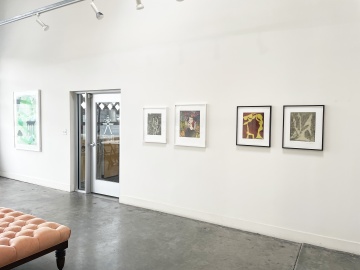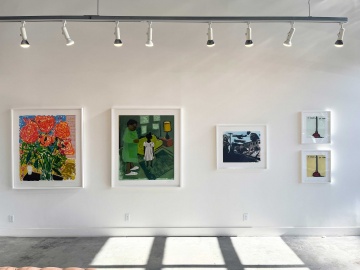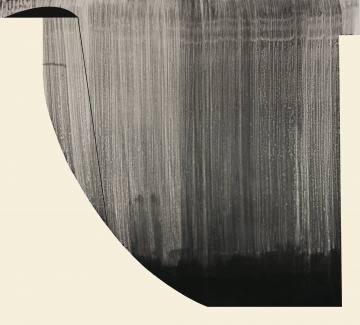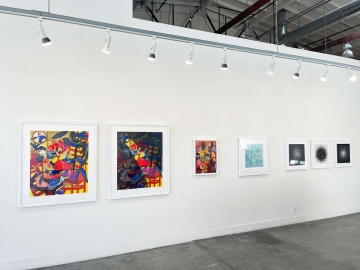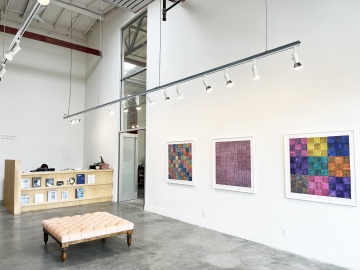Paulson Fontaine Press
2390 C Fourth Street
Berkeley, CA 94710
510 559 2088
Berkeley, CA 94710
510 559 2088
Paulson Fontaine Press (PFP) is a print-making studio, gallery, and publisher that produces limited edition intaglio prints. Established in 1996, the press emerged from the San Francisco Bay Area’s rich tradition of fine-art printmaking. PFP’s philosophy is to facilitate a vision rather than to direct an artist, creating an environment where artists can do their best work. As a woman and minority-owned business, PFP has worked to amplify often-underrepresented voices in the visual arts. PFP’s archive of over 600 editions was acquired by the de Young Museum in San Francisco, CA and a separate archive of over 150 editions by Black Artists was acquired by the Pennsylvania Academy of Fine Art.
Artists Represented:
Edgar Arceneaux
Tauba Auerbach
Donald Baechler
Radcliffe Bailey
Chris Ballantyne
Hernan Bas
McArthur Binion
Ross Bleckner
Christopher Brown
Squeak Carnwath
Woody De Othello
Thornton Dial
Liam Everett
Kota Ezawa
Spencer Finch
Caio Fonseca
Louisiana Bendolph
Mary Lee Bendolph
Loretta Pettway
Loretta Bennett
Essie Bendolph Pettway
Charles Gaines
Isca Greenfield-Sanders
Lonnie Holley
Salomon Huerta
David Huffman
Chris Johanson
Samuel Levi Jones
Maira Kalman
Amy Kaufman
Caroline Kent
Margaret Kilgallen
Ruth Laskey
Hung Liu
Kerry James Marshall
Enrique Martinez Celaya
Alicia McCarthy
Keegan McHargue
Shaun O'Dell
Martin Puryear
Clare Rojas
William Scott
Gary Simmons
Lava Thomas
Hernan Bas, Isca Greenfield-Sanders, Lonnie Holley, Chris Johanson, Caroline Kent, Kerry James Marshall and Shaun O’Dell
America's Best Idea
March 12, 2025 - May 2, 2025
The writer and historian Wallace Stegner called national parks “The best idea we ever had. Absolutely American, absolutely democratic, they reflect us at our best rather than our worst.” At a time when these public spaces are being threatened, and protests are erupting across the country, this iconic quote takes on new importance and meaning.
In response, this exhibition presents a selection of etchings that are depictions of nature and wilderness. Included are works by Hernan Bas, Isca Greenfield-Sanders, Lonnie Holley, Chris Johanson, Caroline Kent, Kerry James Marshall and Shaun O’Dell.
Henry Taylor
Henry Taylor: New Etchings
January 1, 2025 - March 11, 2025
When Henry Taylor arrived at the Paulson Fontaine Press studio earlier this year, he was met with much anticipation. It had been five years since I stood in front of Taylor’s work at the Venice Biennale in 2019. I was at the Arsenale, transfixed by a large triptych measuring about 7 x19 feet. The first panel was a portrait of Toussaint Louverture, the leader of the Haitian Revolution. The second was a painted replica of the artist Glenn Ligon’s text painting titled, “Remember the Revolution #1”, 2004 from his series dedicated to Richard Pryor’s stand-up routines. And lastly, was a painting based on a photograph of mourners at the funeral for Carol Robertson, a victim of the 1963 16th Street Baptist Church bombing in Birmingham, Alabama. This piece perfectly encapsulated Taylor’s breadth of view, showcasing his deep concern with American and art history, the universal grappling with mourning and loss, and the dark humor developed to cope with these human experiences and conditions. In 2020, we began a discussion about making prints together, and since then, the momentum of Henry Taylor: B Side has taken the world by storm. Henry Taylor: B Side is the largest exhibition of Taylor’s work to date and it traveled from MOCA, Los Angeles to The Whitney Museum in New York, surveying thirty years of his work in painting, drawing, sculpture, and installation. Fast forward to 2024. When Taylor first arrived at the press, he began experimenting with sugarlift by painting portraits of our team and it was a beautiful icebreaker. In the words of Alicia Keys, “When Henry walks into a room, he lights up the whole space.” With the energy you might expect from viewing his style of mark making, he experimented with soapground, spitbite, softground, and drypoint. Ultimately, it was the immediacy of the positive mark provided by sugarlift that Taylor ran with. Over the course of the next week, he created a self-portrait, revisited a painting of his late mother and his daughter, and started a piece based on a photo he had taken years ago of a group of men on the streets of downtown L.A. In the print titled History is Everywhere, Taylor pays tribute to Huey P. Newton and the city of Oakland where he took his first printmaking class at Laney college in the late 70’s. One day in the studio, after a conversation at lunch about the state of the world, Henry asked if we had a plunger and proceeded to paint it with the words, “It about to Go Down.” During a second visit to the studio in August, inspired by painter Max Beckmann, he rendered a gorgeous still life of a bouquet of roses we had placed in the studio on his behalf. It’s this voracious vacillation that makes his work so exciting and compelling. The writer Zadie Smith wrote about Taylor, “If it has been the tendency of African-American artists to stray heedlessly over academic borders and genre demarcations (rap is popular poetry; jazz produces improvised symphonies; gospel is the sexual sacred), then Taylor is firmly grounded in the African-American aesthetic tradition. His greatest subject is human personality, although in his portraits, personality is not a matter of literal representation but rather a vibe, a texture, a series of vertical block colors laid out on a horizontal plane. This restates the obvious fact that seeing is never objective, but the intense level of empathy we meet with in Taylor’s portraits, especially between the artist and his African-American subjects, determines everything we see from brushstroke to framing to gaze.” Henry Taylor is one of the most significant artists of his generation, and we are honored to publish ten new editions introducing his first major print project. -Rhea Fontaine
Charles Gaines
Charles Gaines: New Etchings
June 1, 2024 - August 31, 2024
Charles Gaines is a Los Angeles based artist whose work is rooted in conceptual art.
He employs the use of systems, most often in the form of the grid, to make drawings, photographs, and video installations. Committed to conceptual principles, Gaines is one of the few African American artists who worked in this genre during the 1970’s, creating a conversation with the practices of Sol LeWitt, Mel Bochner, John Cage and Lawrence Weiner. His exploration of abstraction and aesthetics as means to explore ideas about perception, objectivity, and relationships has influenced a younger generation of artists including: Edgar Arceneaux, Gary Simmons and Mark Bradford. Recent exhibitions include a survey show titled “Charles Gaines: Gridwork 1974–1989” organized by The Studio Museum in Harlem in 2014 and exhibited at The Hammer Museum in Los Angeles the following year. “Charles Gaines 1992-2023” opened at the Institute of Contemporary Art, Miami in 2023. Charles Gaines is represented by Hauser & Wirth and Galerie Max Hetzler in Berlin.
Monumental Form: Torkwase Dyson and Martin Puryear
January 22, 2024 - March 31, 2024
Torkwase Dyson describes herself as a painter working across multiple mediums to explore the continuity between ecology, infrastructure, and architecture. Dyson’s abstract works are visual and material systems used to construct fusions of surface tension, movement, scale, real and finite space. With an emphasis on the ways black and brown bodies perceive and negotiate space as information, Dyson looks to spatial liberation strategies from historical and contemporary perspectives, seeking to uncover new understandings of the potential for more livable geographies. Dyson has participated in group exhibitions at the Smithsonian National Museum of African Art, Washington, D.C.; Whitney Museum of American Art, New York; The Museum of Modern Art, New York; and California African American Museum, Los Angeles, and has had solo exhibitions and installations at Colby College Museum of Art, Waterville, Maine; Graham Foundation for Advanced Studies in the Fine Arts, Chicago; Schuylkill Center for Environmental Education, Philadelphia; and Suzanne Lemberg Usdan Gallery, Bennington College, Vermont. Dyson is represented by Pace Gallery in New York and Gray Gallery in Chicago.
Sculptor, Martin Puryear employs wood, mesh, stone and metal to create forms that resist identification. His objects and public installations are a marriage of minimalist logic with traditional ways of making. Puryear represented the United States at the Bienal de São Paulo in 1989, where his exhibition won the Grand Prize. Puryear is the recipient of numerous awards, including a John D. and Catherine T. MacArthur Foundation Award, a Louis Comfort Tiffany Grant, and the Skowhegan Medal for Sculpture. Puryear was elected to the American Academy and Institute of Arts and Letters in 2007 and received an honorary doctorate from Yale University in 1994. His work is included in the permanent collections of the Museum of Modern Art, NY, The Getty Museum, Los Angeles, The Corcoran Gallery of Art, Washington D.C. and the National Gallery of Art, Washington D.C. among others. He is represented by the Matthew Marks Gallery, NY.
Markers of Time: Ross Bleckner, Woody De Othello, Chris Johanson and Martin Puryear
October 10, 2023 - December 31, 2023
Markers of Time includes works by Ross Bleckner, Woody De Othello, Chris Johanson and Martin Puryear.
Ross Bleckner’s etchings: Early Every Morning, Early Every Evening, Eclipse, Shadow, Spinning and Winter are all observations and meditations on shifting shadows and light, mapping changes in nature.
Woody De Othello’s interior scenes playfully collapse into themselves through layers of bright color and domestic form. Clocks, light switches, lamps and hourglasses point to the passing of time and the reverie of both the Surrealists and California Funk artists.
Shoulders State 1 and State 2 are characteristic of Martin Puryear’s etchings. He often creates editions in stages, keeping his original plates to return to later. His sculpting process is often reductive, and with the etchings the removal of copper with acid becomes additive, pushing the image further into new space.
Chris Johanson’s work grapples with the energetic immediacy of the present, the hope of the future, and the expansiveness of forever. Often using text, his free-flowing messages cut through time and place and leave us to consider our human experience.
McArthur Binion
McArthur Binion: New Etchings
June 1, 2023 - September 30, 2023
For his latest iteration of prints, Chicago-based painter McArthur Binion (b. 1946, Macon, Mississippi) presents nine distinct editions, titled Berkeley:Suite 10-15 and Sixteen:Square 1-3.
The formal and conceptual bedrock of the new works, what Binion calls his “Visual:Ear,” draws an ecstatic loop in the artist’s practice: The editions mark a return to an idea first crystalized over 50 years ago while he pursued his MFA in painting at Cranbrook Academy in Bloomfield Hills, Michigan. Binion coined the phrase while making a drawing titled Drawn Symphony:In:Sane:Minor, 1971 and it remained dormant in his mind, but nonetheless present for decades. The concept was then reactivated and visualized on the occasion of Visual:Ear, a solo-exhibition presented by Xavier Hufkens Gallery in 2022, for which these prints served as a testing ground. According to the artist, this series represents “the clarification of my character as a painter.”
Since the genesis of his DNA series in 2013, Binion’s artworks have consistently sprung forth from a base layer of imagery that the artist names the “underconscious,” atop which he layers pigmented ink and paint stick to form the frenetic geometric shapes and patterns that denote his signature aesthetic. Formerly, the “underconscious” has been almost exclusively made up of reproduced images of Binion’s personal ephemera, like his address book, birth certificate, childhood home, and portraits taken at various stages throughout his life. For his Visual:Ear works, though, the “underconscious” is made up of a musical score titled Still Standing Stuttering, which Binion commissioned from Pulitzer Prize winning composer Henry Threadgill. Thus, this particular series denotes a new horizon for his oeuvre, in that it further abstracts Binion’s auto-biographical presence in the work.
The title of the score draws another loop in the artist’s practice, in that it is culled from a painting titled Stuttering:Standing:Still, 2013, which was dedicated to Binion and Threadgill’s mutual friend, Butch Morris, who was also a conductor and composer. Music, particularly jazz, has long been a significant influence on Binion’s practice, as he rubbed shoulders with musicians like Cecil Taylor, Olu Dara, Julius Hemphill and Butch Morris, as mentioned above, when he lived in New York in the 1970’s and 80’s.
It also bears noting that Binion, from a young age, became adept in modes of communication that exceed the verbal, as demanded by his verbal stutter: “The visual ear is a [form of] non-verbal communication,” says the artist. With this in mind, this new body of work invites us to rely on all our senses as forms of evidence and knowledge production and gives credence to the fact that spoken language is not the only way we come to know, connect with and relate to one another. Ultimately, probing sensorial questions that range from the mundane to the existential, these prints propose the supreme value of learning to look by listening, and likewise, learning to listen by looking.
-Camille Bacon

 Back to all Member Galleries
Back to all Member Galleries

